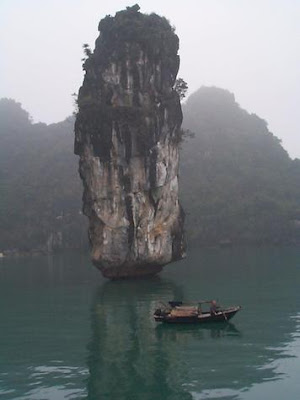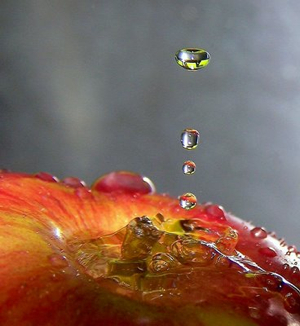
The rock serves as a center of interest for this picture. The rock, being slightly off-center, is more interesting than if it had been placed in the center of the composition. The reflection of the rock in the water serves to extend the rock's original line. In fact, the rock and its reflection almost completely dissect the composition from top to bottom. The reflection of the rock helps to draw the eye to the only other object in the foreground, the boat.
The boat is a clearly defined form. Its color is distinct from the water surrounding it and provides contrast witht the water and harmony with the bare rock. The boat is much less weighty than the rock beside it because it is so much smaller. Though the rock is really the center of interest, the boat does share in the impact because it is the only other object in the foreground.
The composition is nicely balanced. The background utilizes the rule of thirds with the sky, the mountains, and the water each taking up approximately a third of the space. The rock and the boat provide an approximate balance in the foreground. Over all, the composition displays an approximately symmetrical vertical balance.
The color scheme of the picture is very natural; it uses mostly greens, browns, and neutrals. The more vibrant color of the water at the bottom of the picture helps to anchor the composition; the water gives the bottom of the picture a little more weight than the white sky at the top. The mountains serve to tie the vastly different hues of teh water and sky together. The vast difference between the water and the sky, though, offers a nice contrast, adding interest and eye movement to the picture.
-Kim Spann












 This is an interesting photograph from a Nissan advertisement. The composition of the photo is really appealing and the perspective of the shot gives it depth and draws the viewer into it. The visual lines, such as the horizon and edge of the road, and the implied lines, such as the beam of light shining down on the car and the headlight, all radiate towards the car, which is the center of interest. The blue-green darkness of the lower left portion of the photograph is contrasted by the intense yellow light of the upper right portion. This color scheme based on complementary colors gives the photo balance and visual stability.
This is an interesting photograph from a Nissan advertisement. The composition of the photo is really appealing and the perspective of the shot gives it depth and draws the viewer into it. The visual lines, such as the horizon and edge of the road, and the implied lines, such as the beam of light shining down on the car and the headlight, all radiate towards the car, which is the center of interest. The blue-green darkness of the lower left portion of the photograph is contrasted by the intense yellow light of the upper right portion. This color scheme based on complementary colors gives the photo balance and visual stability. 







